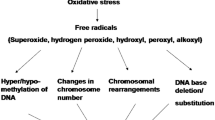Abstract
The genetic control of Endosperm Balance Number (EBN), a mechanism of effective ploidy that controls seed development, was studied using aneuploidy. The Endosperm Balance Number hypothesis proposes that each species has an effective ploidy (EBN) in the endosperm and that it is the effective ploidies, rather than the numerical (actual) ploidies, that must be in a 2:1 maternal to paternal ratio for normal endosperm development. Experiments were conducted in Datura stramonium L. (2n=4x=48) to determine if more than one chromosome but less than the whole genome could change the EBN of the female. Triploids were crossed with tetraploids to produce aneuploids. Most plump seeds gave rise to 2n=4x=48 chromosome plants. Six plants had between 38 and 47 chromosomes. Karyotyping of these plants supported the conclusion that only two chromosomes (1.2 and 19.20), when extra, were necessary to change the EBN of the central cell.
Similar content being viewed by others
Author information
Authors and Affiliations
Additional information
Received: 25 April 1998 / Revision accepted: 25 January 1999
Rights and permissions
About this article
Cite this article
Johnston, S., Hanneman Jr., R. The nature of the genetic control of Endosperm Balance Number based on aneuploid analysis of Datura . Sex Plant Reprod 12, 71–75 (1999). https://doi.org/10.1007/s004970050174
Issue Date:
DOI: https://doi.org/10.1007/s004970050174




